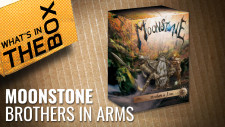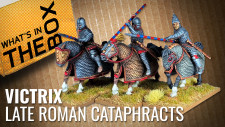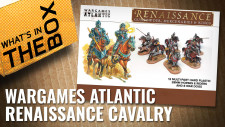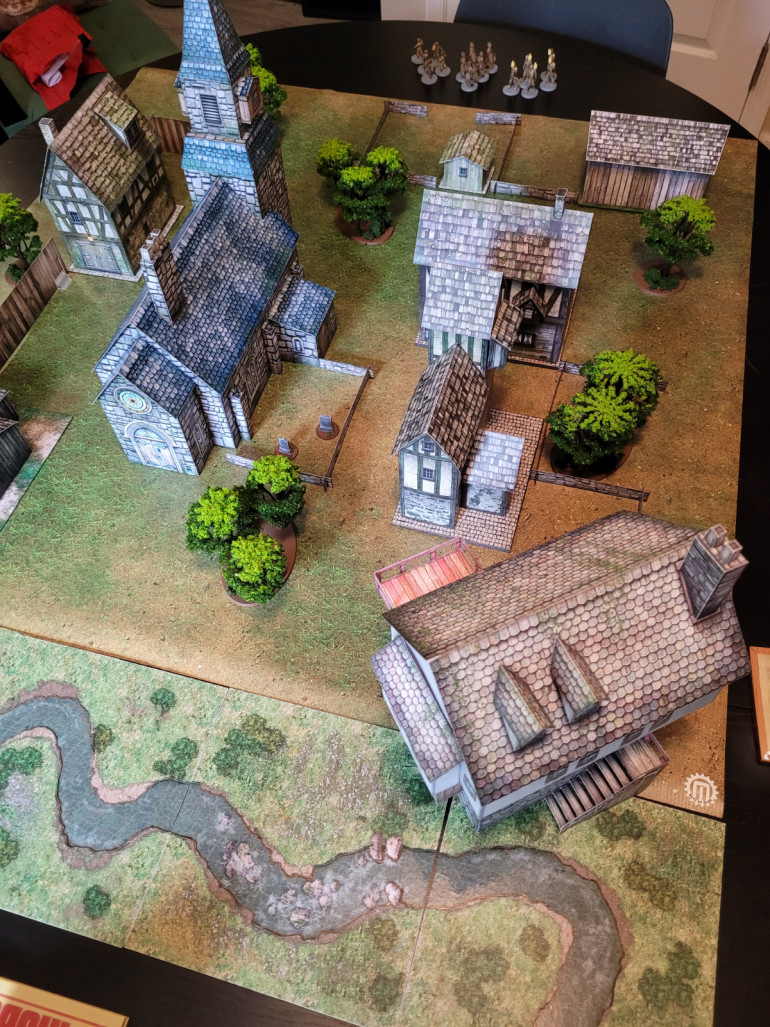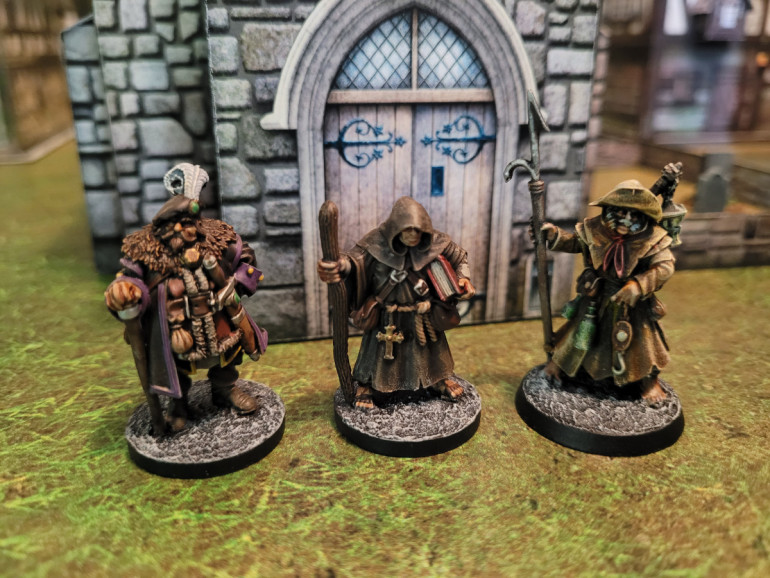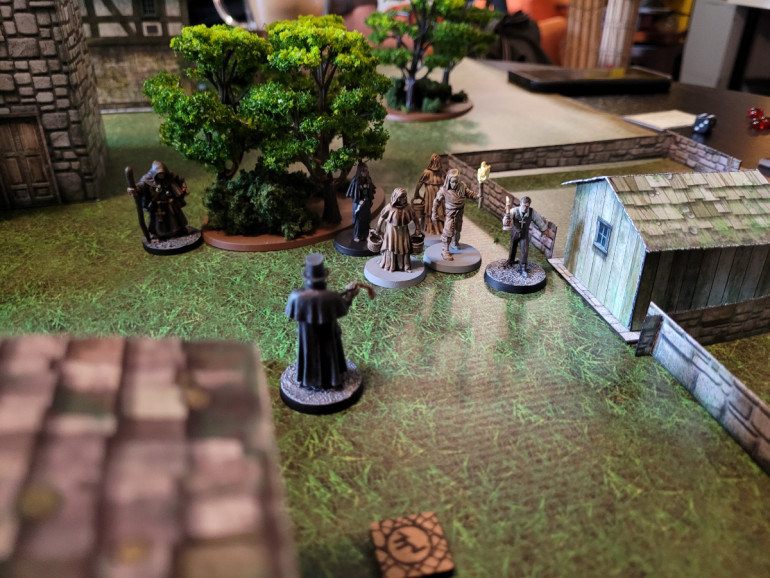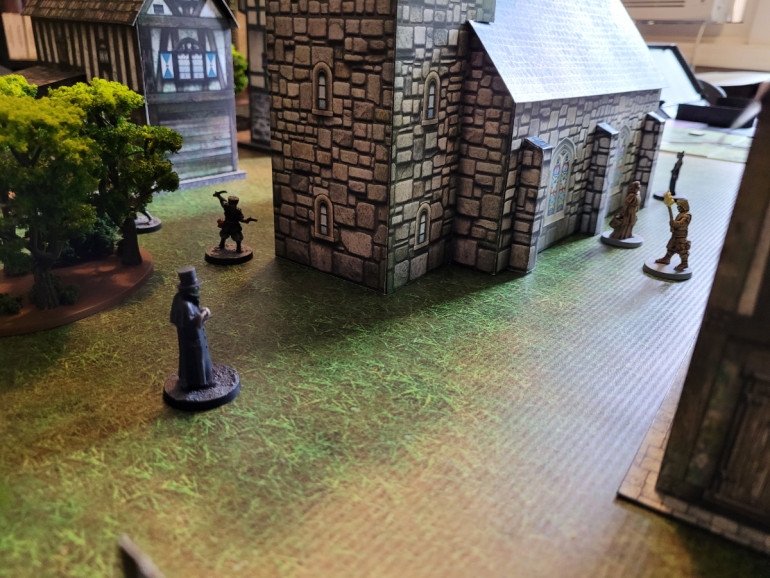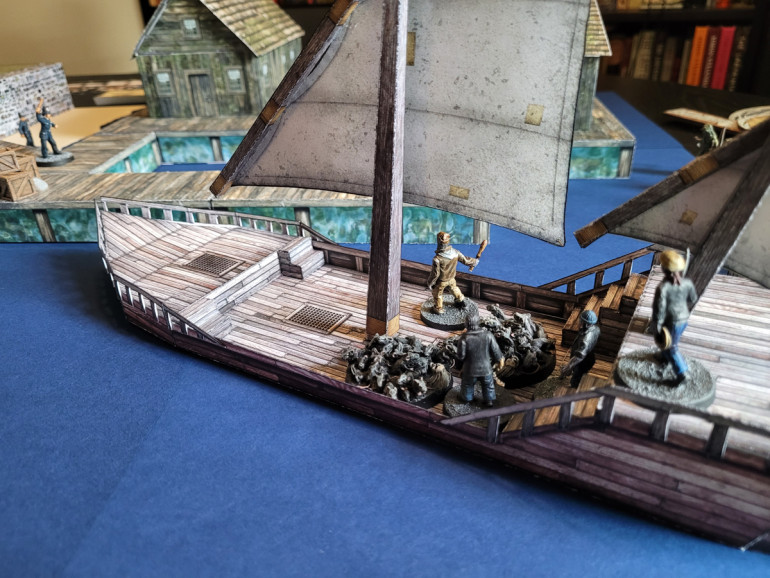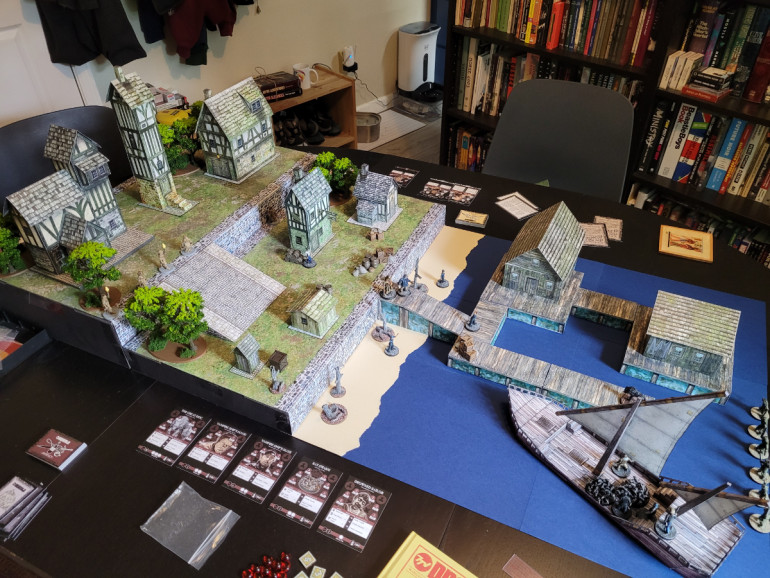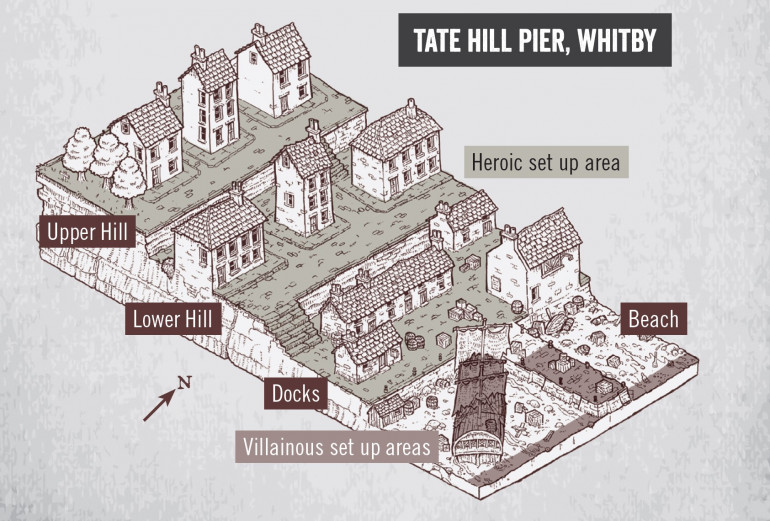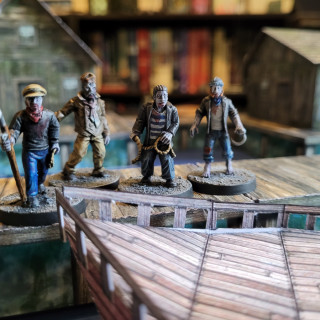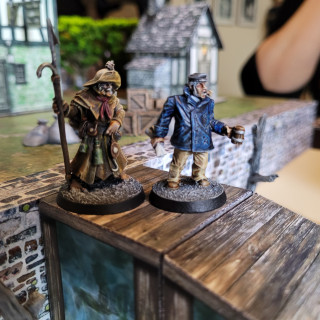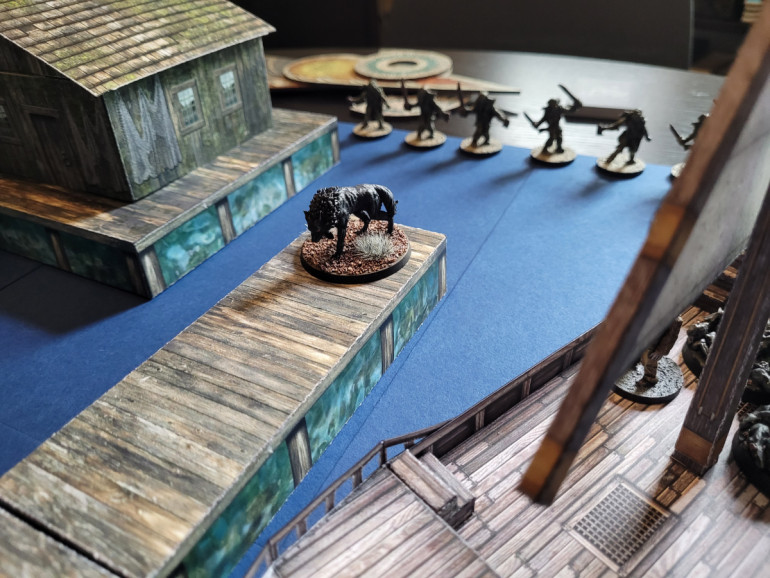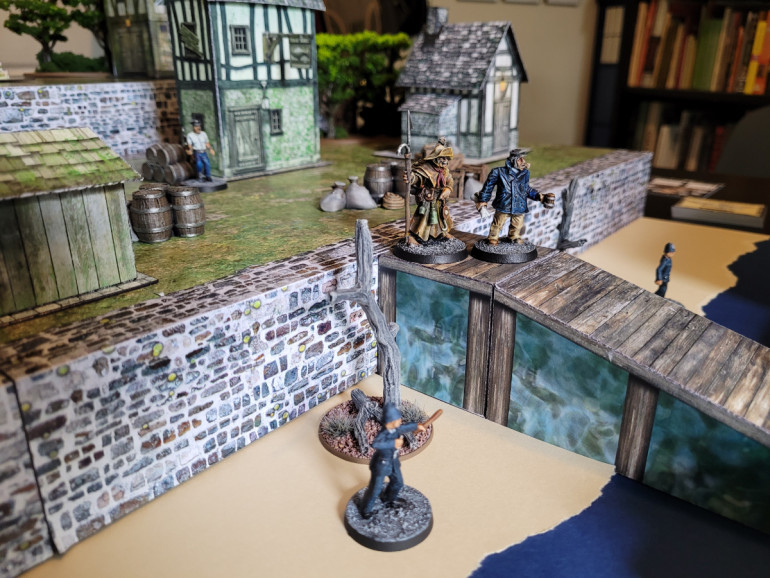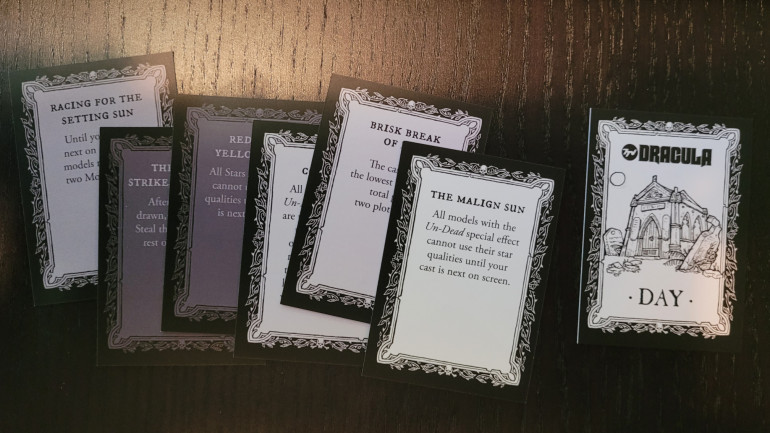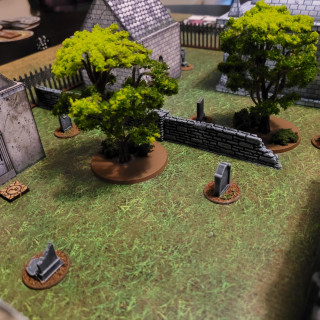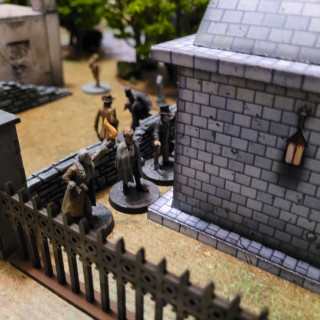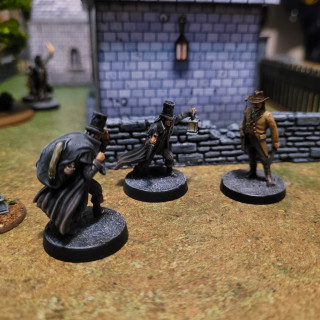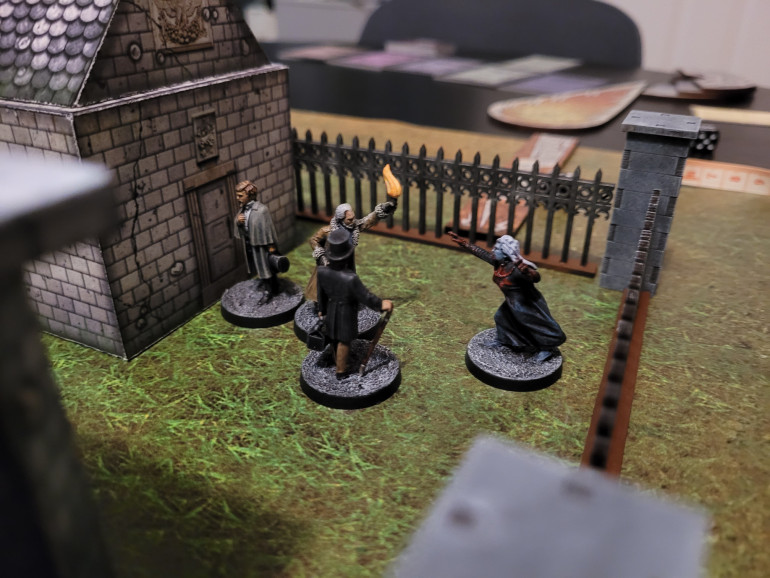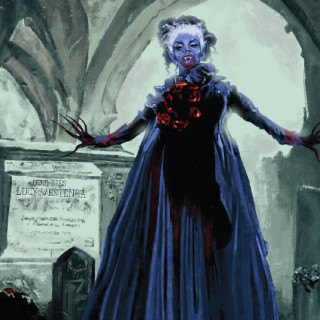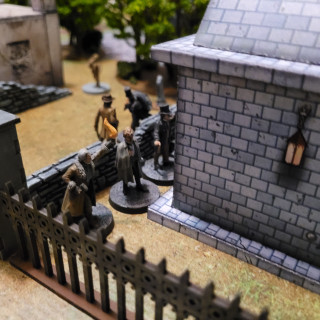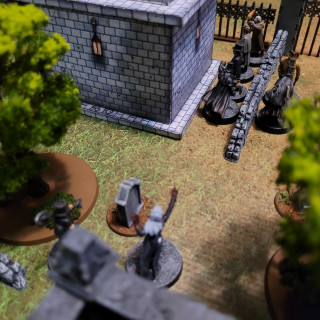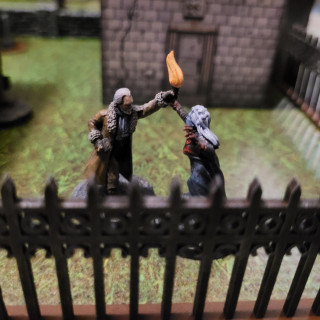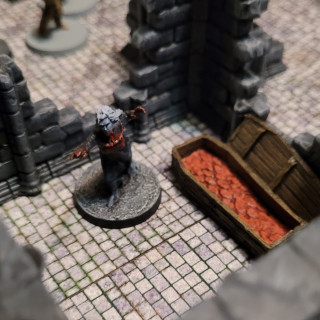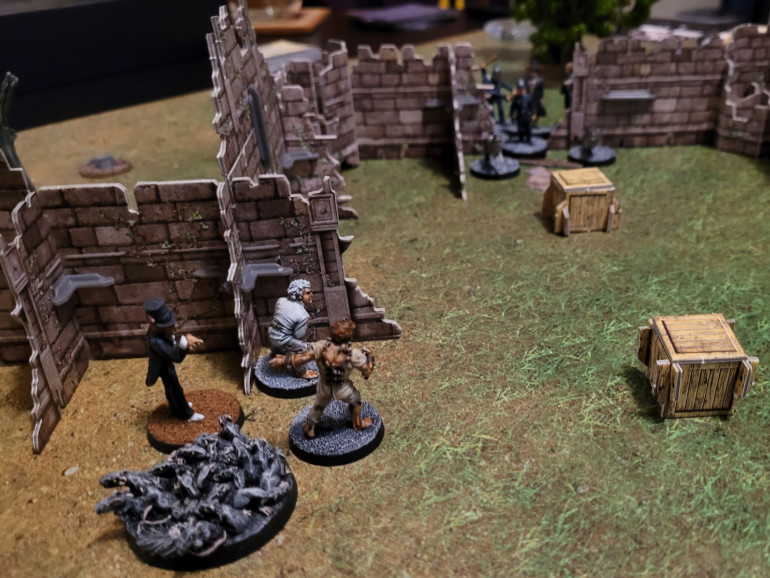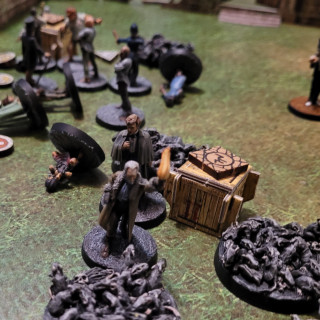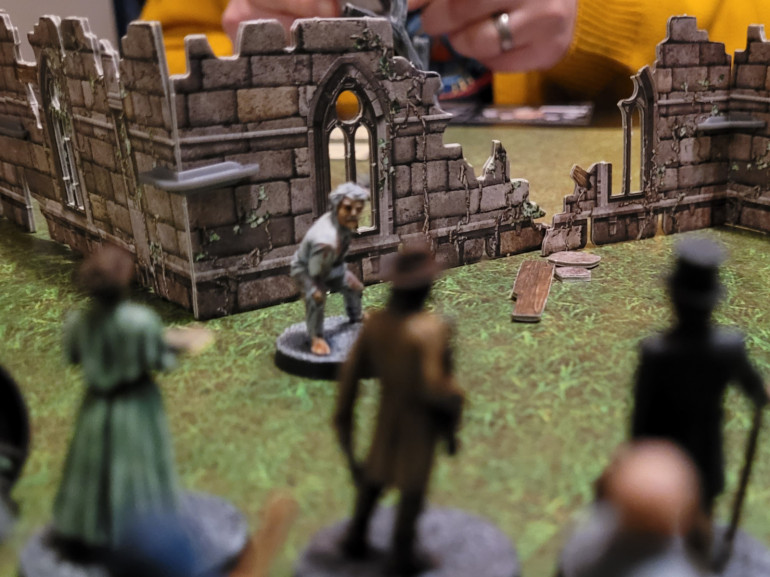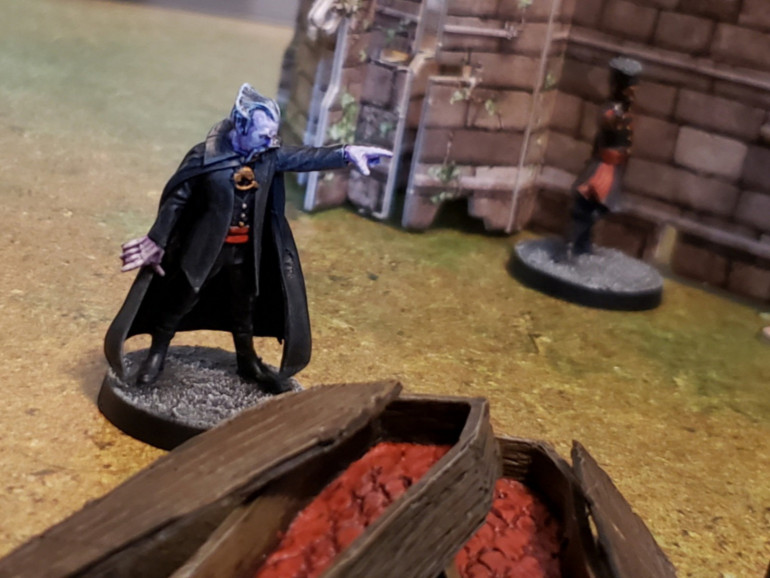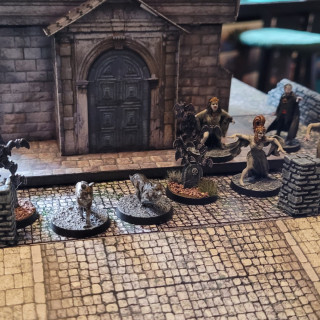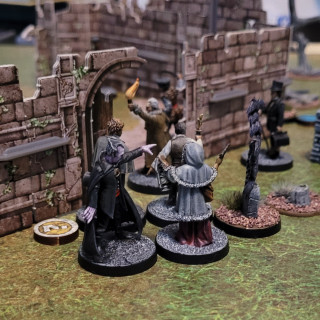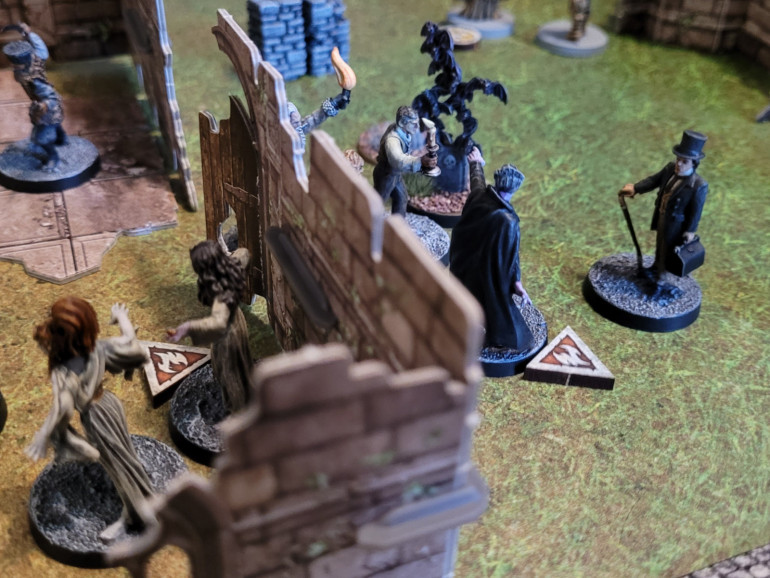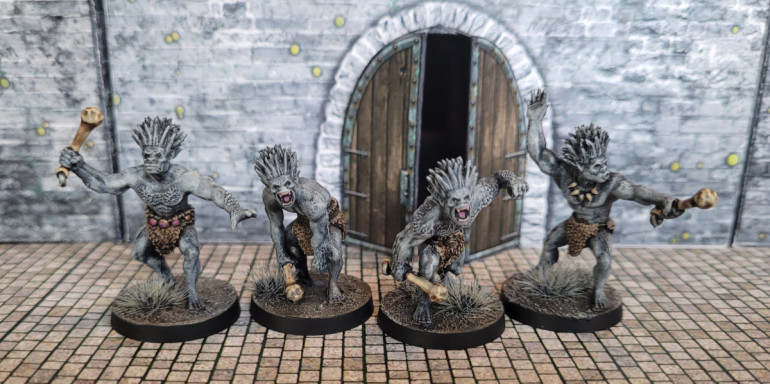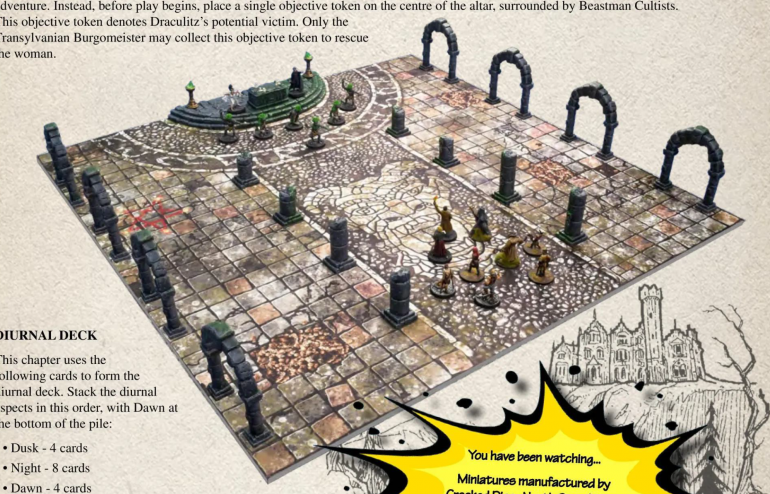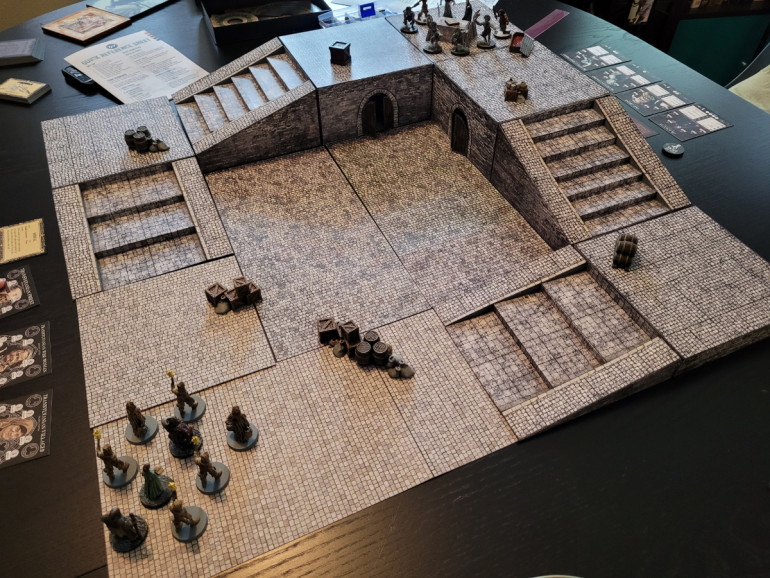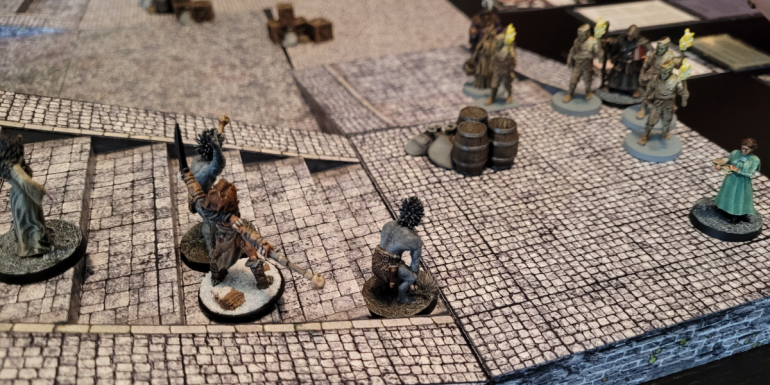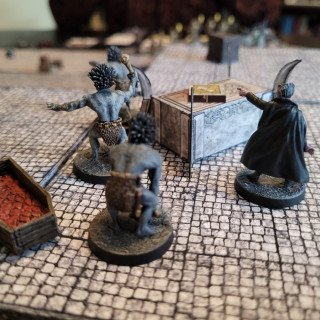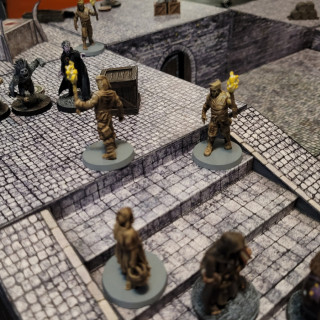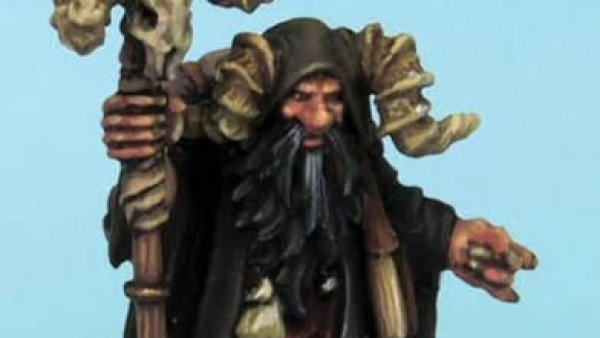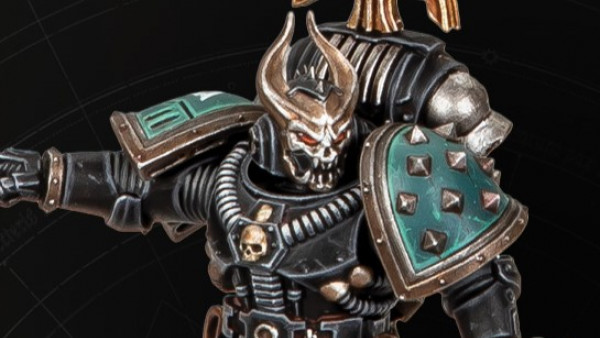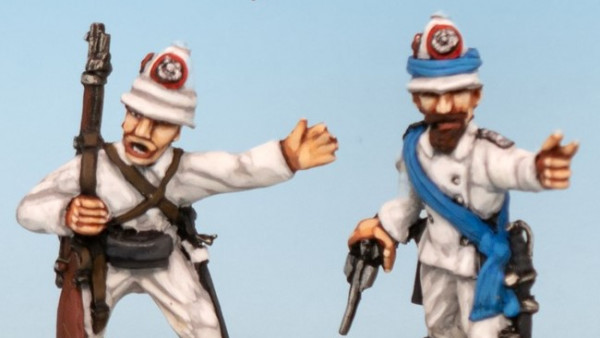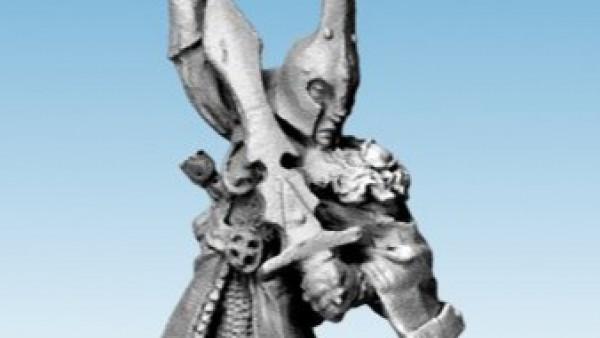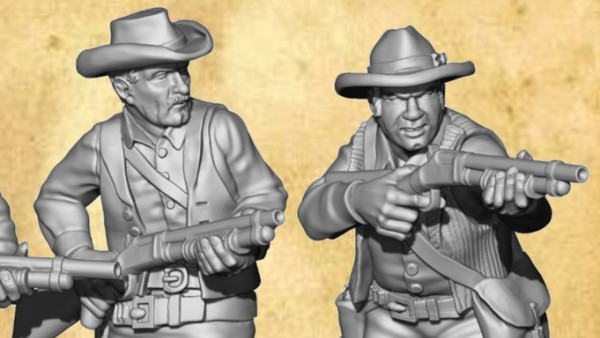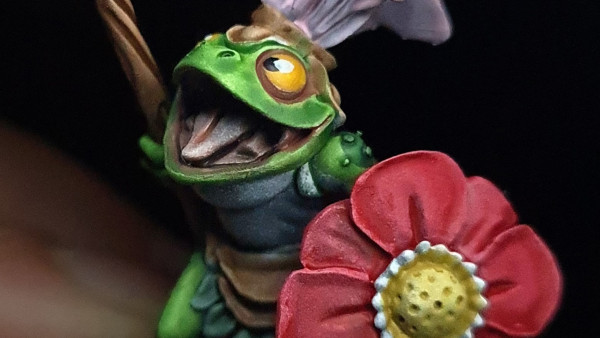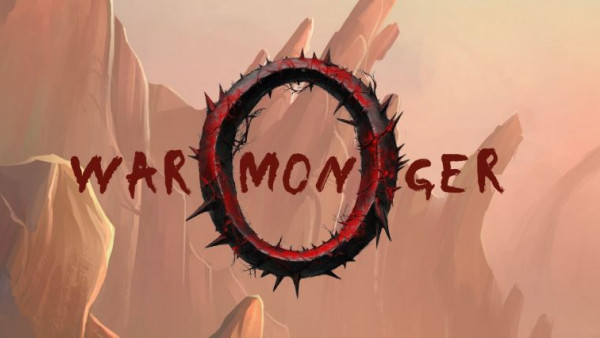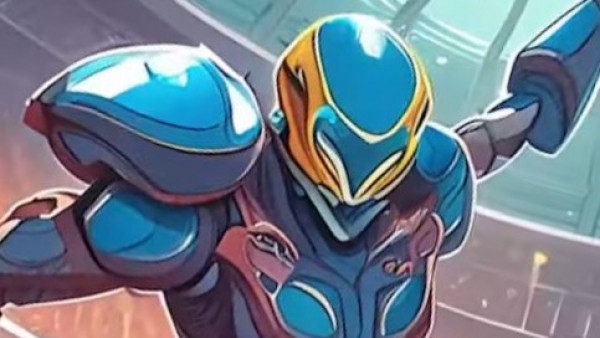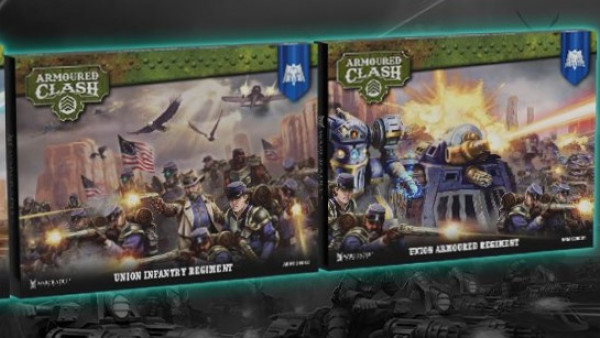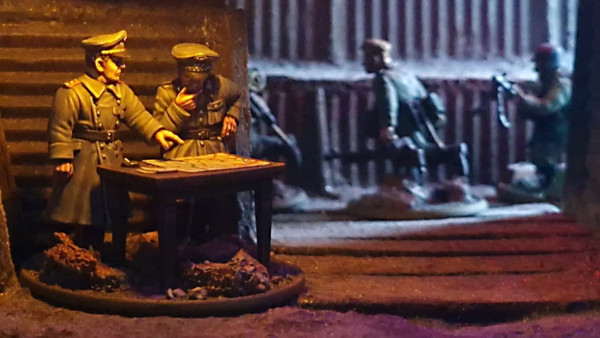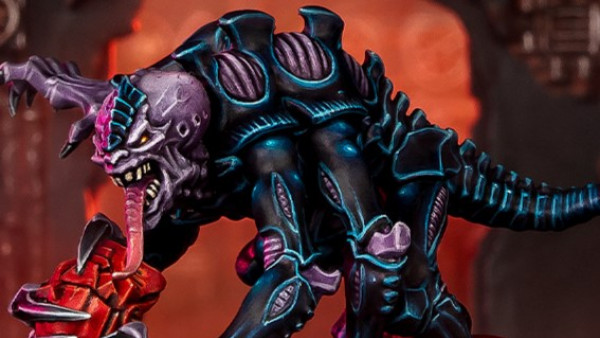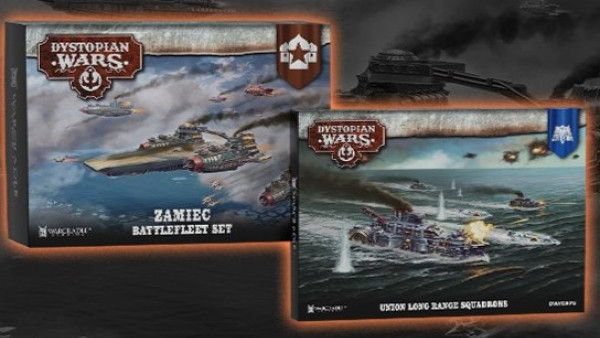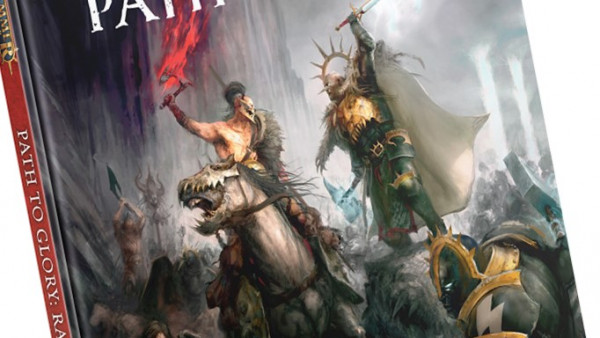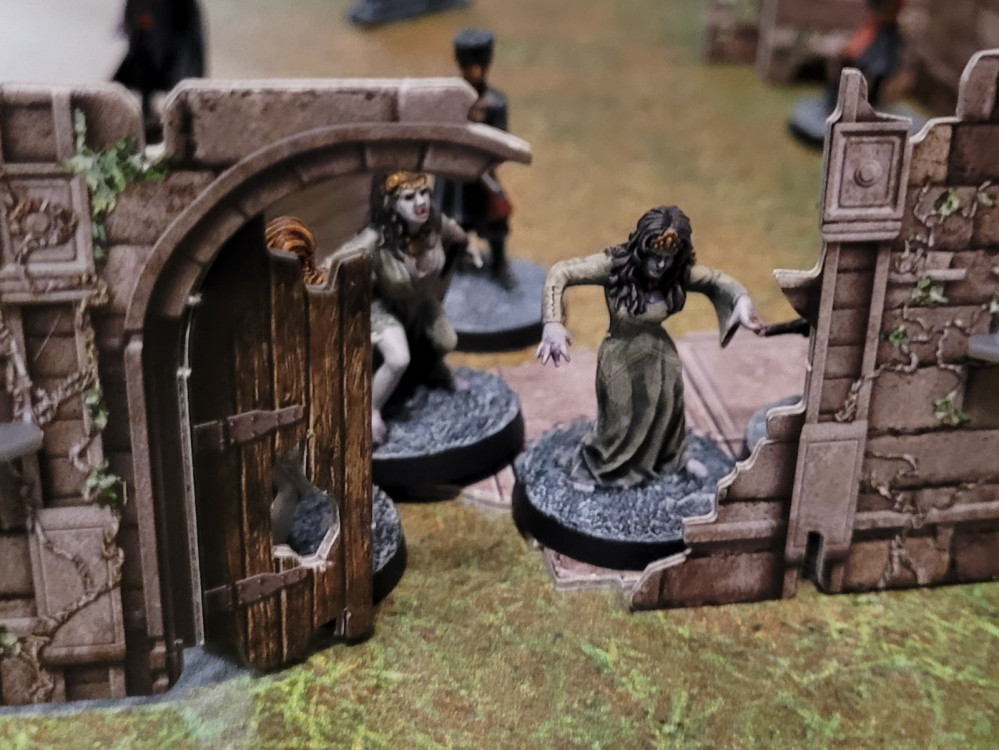
7TV Dracula Campaign Playthrough
Recommendations: 119
About the Project
Crooked Dice's 7TV is a highly thematic, scenario-led game. The Dracula scenario pack is no exception, with 5 scenarios extrapolated from the original novel. The scenarios require some wildly different table layouts, many needing terrain that I don't have in my collection, so one of the challenges is to set up each chapter as close as possible to what the rules are asking for, without breaking the bank or drowning in buildings I'm not likely to use again.
Related Game: 7TV
Related Company: Crooked Dice Game Design Studio
Related Genre: Horror
This Project is Completed
Chapter 1: Jonathan's Escape
The campaign consists of 5 two-player games, the Agents of Light and Their Allies vs. the Un-Dead and Their Servants. The first scenario concerns Jonathan Harker’s escape from Dracula’s Castle with the help of some Transylvanian villagers.
This scenario takes place in a quaint eastern European village. Luckily I had some papercraft buildings left over from a 7TV game I did several years ago based on the 60s TV series The Prisoner, so the only new piece I needed for this was a church. All the other buildings are from David Graffam Models, and luckily he had a pretty impressive church model available which I was able to print and assemble without too much work.
The original idea was to use print-and-assemble papercraft buildings so I could just throw them in the recycle when we’re done, but I have to admit that so far I’ve held on to everything. We’ll see how quickly I run out of space…
The Kickstarter for this scenario pack provided most, but not all, of the miniatures needed for the scenarios. 7TV has always been a miniatures-agnostic game, and the assumption is that players will already have basic figures like villagers, priests, and the like. However, the overwhelming majority of my collection consists of science fiction characters, so I had to scramble a bit to make up the difference.
These three fellows came from Reaper Miniatures (we’ll meet the fellow on the right in chapter 2). The Reaper figures are a bit larger and more cartoony, but since the conceit of 7TV is that we’re playing out a made-for-television movie, I reasoned that some of the minor characters might have been cast with American comedians in an effort to boost the movie’s appeal in the lucrative US TV market…
For the Transylvanian villagers I borrowed some generic-looking villagers from the Monolith Conan board game.
The scenario is deceptively simple: Jonathan Harker has to get across the board to the river in order to escape. Along the way he can try to pick up objective tokens that will improve his player’s score but also put a game effect into play. These effects start out helping the Dracula player but eventually start helping Harker’s escape.
One thing that made this scenario tricky for the Dracula player was that the Un-dead (his two most powerful characters) couldn’t come within two inches of the church, which was dead-center on the board. It made maneuvering a little complicated, and as the Dracula player I had a hard time keeping up with Harker since my opponent decided to skip most of the objectives and just race for the finish line.
In spite of the Countess Dolingen von Gratz’s best efforts to blockade the river, the kindly villagers were able to keep her busy long enough for Jonathan Harker to escape across the river, resulting in a win for my opponent and the Agents of Light.
The game uses a deck of cards, the Diurnal Deck, to mark the passage of time through dusk, night, dawn and day (important distinctions for a game about vampires) and add an overarching game effect at the end of each turn. My opponent’s victory means that the Diurnal Deck for the next game will have one fewer night card and one additional day card, which will surely be a disadvantage for the forces of evil…
Chapter 2: The Battle of Whitby
In Bram Stoker’s novel, the ill-fated Demeter arrives in the sleepy fishing village of Whitby, its crew missing and its only passengers a horde of rats and a giant dog the leaps off into the night. For 7TV Dracula this chapter is a bit more action-packed, with heroic customs agents facing off against vampire sailors and reanimated corpses in addition to the aforementioned wildlife.
The goal of the scenario is similar to chapter one, except this time the forces of evil need to get their main character, The Great Dog (a transformed Dracula), across the board to safety. To assist, the Dracula player has a selection of undead sailors and two swarms of rats.
I went with papercraft buildings again, and while the scenario rules made allowances for a flat board, I decided to construct a multi-level board as close as possible to what is pictured in the scenario book. Most of the buildings and the ship, as well as the grass and rock textures, are from David Graffam Models again, with the docks and dockside buildings coming from Fat Dragon Games, all PDFs by way of DriveThruRPG.
I was able to use stock Crooked Dice models for the policemen (moonlighting as customs officials), and most of the sailors (painted up to be more vampiric), with Reaper again making up the difference by providing a larger-than-life Harbormaster and Chief Customs Officer, plus a small horde of zombie pirates. The Great Dog and the rat swarms are the only models in this chapter that are specifically from the 7TV Dracula Kickstarter.
In theory, all the Dracula player has to do is get the Great Dog from the ship to the other end of the board. However, the 2×4 board means that the dog has more ground to cover than Jonathan did in Chapter 1, and the multi-level nature of the battlefield creates several bottlenecks moving from one level to the next.
Another huge disadvantage is that a large portion of Dracula’s forces start at the very edge of the board, in water that slows their already slower than average movement. by the end of the game I had barely managed to get the zombie pirates to the center of the board, and none of them had actually done anything other than move. I must admit, however, that this problem may have been at least partially of my own making, as I chose to set up the docks part of the board a little differently than what was pictured in the rulebook.
The Agents of Light player started with all their forces at or near the center of the board. My opponent made short work of the two rat swarms, and was able to stall the rest of my forces at the bottleneck where the dock meets the land. The Harbormaster has an ability that allows him to place obstacles on the board, and unfortunately a misreading of the rules for moving past obstacles made this a much bigger impediment than it should have been.
Eventually it occurred to me that the Great Dog could just jump from the beach, but it was a little too late. The dog made it past the blockade, but then got mobbed by villagers, although he did manage to take a few of them out before his ignoble end.
As a reward for my opponent’s victory, she’ll have the initiative at the start of the next game, and one of Dracula’s co-stars will be delayed by a turn in chapter 4.
While I think this chapter was a little difficult for the Dracula player, I do have to concede that a lot of that was probably user error on my part, and we both enjoyed the game in any event.
Wow! A Golden Button!
I’m beyond thrilled to receive a Golden Button award for this project! I’ve been watching the Weekender for years but I’ve only recently made more of an effort to participate in the community. Thanks Ben and the rest of the team!
Chapter 3: A Hampstead Mystery Revealed
In the novel, the heroes face their first crushing defeat when they fail to prevent Dracula from feeding on the innocent Lucy Westenra and eventually turing her into one of the foul Un-dead. Soon after she is supposedly laid to rest in the Westenra family crypt, there is a rash of disappearing children in a nearby village, and reknowned vampire hunter Van Helsing knows who is responsible. He assembles a team of stalwarts from among Lucy’s many suitors to steal into the graveyard, find the missing children, and put Lucy’s soul to rest.
What this means for the game is that there is quite a bit more going on in this scenario. The model count is smaller, with 4 models for the heroes and 8 for the vampires, but each side has to accomplish a lot more that just getting one of their characters to the other side of the board. The heroes get victory points for rescuing the kidnapped children — some have been pressed into service by the vampiric Lucy, while others are locked in crypts scattered across the board. They also score points for permanently removing Lucy from play, a task that is a little more difficult than merely defeating her in combat. Meanwhile, the villains score their points based on how many children go unrescued, plus a large bonus if Lucy’s fiance Arthur Holmwood ends the game with the “bitten” status.
Using print-and-assemble papercraft terrain proved to be a huge advantage in the setup for this chapter. I needed five crypts, and it was an easy matter to just print out five copies to assemble. Even better, the David Graffam PDFs usually come with a fair number of different options for textures and details, so I was able to make each crypt look a little different from the others.
I do find that, while it’s great for solid buildings, papercraft tends to look a little flimsy when used for walls and interiors, so I decided to step up my terrain game just a little by buying some 3D low stone walls (which should be useful in a lot of different games). Additionally, the 7TV Dracula Kickstarter campaign came with an add-on for some gothic walls and pillars. They look great on the table, but after spending an entire weekend painting stone walls I’ll be happy to get back to pre-colored buildings…
I haven’t spoken too much yet about the Diurnal Deck. For those of you unfamiliar with 7TV, it’s a deck of cards that serves as a timer for the game, and also spices things up by introducing a random effect at the start of each turn that can be to the benefit or detriment of either or both players. My opponent won the initiative automatically since she won the previous chapter — her first Diurnal card was “Race for the Setting Sun,” which forces both of us to only give movement actions to all of our models for the first turn. She decided to use that to her advantage by making a beeline for the first crypt — clearly she’s going to focus on rescuing the children rather than engaging the vampiric forces directly.
Another fun wrinkle in this chapter is that each time a heroic character ends a move action near a gravestone, my opponent has to roll for a possible effect. The first such roll produced the “nails and splinters” effect, which allows me to move my Un-dead model closer to the affected hero.
I decided, perhaps foolishly, to try to score the extra points for biting Arthur Holmwood, so my first moves were pretty agressive, moving my Mesmerized Gravediggers in to engage my opponent’s forces while I sneak Lucy around the first crypt to make a beeline for Arthur. Even under a restriction that disallows use of his firearms (must be quiet in the graveyard, after all), Quincy Morris, the heroic Texan, made short work of my Gravediggers, and before long I’m left with only a handful of semi-vampiric children to support my star. No matter, if Lucy can just score one hit on Arthur Holmwood he’ll have the Bitten status, and she can use her “Diabolical Sweetness” Star Quality (a unique special ability) to Dominate Arthur, which means I’ll take control of him, giving a boost to my depleted forces.
I spent a few turns maneuvering Lucy into position, but when I was poised to make my move, my opponent drew the Diurnal card “Red Eyes, Yellow Moon” which prevents all models from using their Star Qualities. Drat! The events in the Diurnal deck had a much more decisive effect on this game than in either of our previous chapters. The restrictions certain cards placed on our turns guided strategy for both players, forcing us to adapt to a changing game environment, and this was also the first chapter where the game ended entirely due to the Diurnal deck running out, rather than by one player decisively achieving their objective.
The game went downhill for me from there, with a series of bad rolls on my part and smart tactics on my opponent’s part wearing Lucy down. In this scenario, when Lucy would be defeated she instead is relocated to her crypt, which she can no longer leave. The heroes can destroy here for good by entering the crypt and destroying her coffin, but seeing that time was short, my opponent elected to focus on rescuing the childrem instead, which landed her a Marvelous victory. She’ll get a head start on her tasks in chapter four, which looks to be an interesting one…
A few more images from Chapter 3
In case you were wondering why Lucy doesn’t have the usual blonde hair and white nightgown, I wanted her to look like the cover artwork to the 7TV Dracula Episode Guide.
Here are a few more images from Chapter 3 that I couldn’t quite squeeze into the main entry.
Chapter 4: The Purging of Carfax
In this chapter, the forces of light have worked out that Dracula needs to rest in earth from his homeland. They’ve found the final boxes of earth at Carfax abbey, a ruined monastery near Dr. Seward’s lunatic asylum. Unfortunately for our heroes, Dracula’s sinister lackey Renfield has arranged a mass breakout, and Carfax is soon to be overrun by escaped lunatics…
The setting for this chapter is the aforementioned ruined monastery. I couldn’t find anything I liked for this in paper terrain, so I decided to go with the next best thing: Battle Systems. But which kit to use for a ruined monastery? Ah, the “Ruined Monastery” set ought to work…
The heroes’ goal is to consecrate six boxes of earth that have been scattered throughout the battlefield. As the forces of darkness, all I have to do is prevent them from achieving their goal — at the end of the game, the heroes get a point for every box of earth they’ve consecrated (by having one of the main characters spend an action while adjacent), while I get a point for every box they don’t get to.
In chapter 3 I mentioned the Diurnal Deck which serves as the game’s countdown mechanism. After the first turn of the game, each player has the option to flip over two Diurnal cards instead of one. Doing this immediately gives each player two plot points (the currency the game uses to pay for unit activations and some special abilities), but more importantly, it allows some ability to accelerate the end of the game.
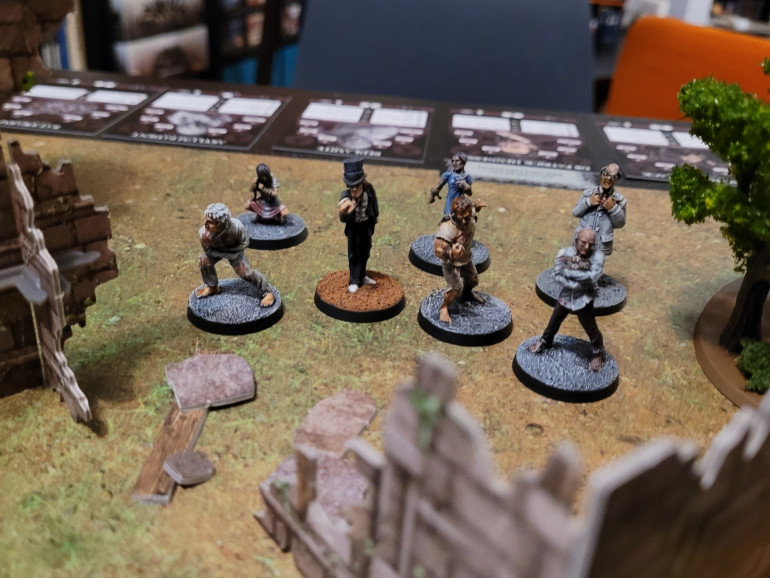 In case you were wondering, the fellow in the top hat is Spring Heeled Jack, also coincidentally locked up in the asylum right next to Dracula's place.
In case you were wondering, the fellow in the top hat is Spring Heeled Jack, also coincidentally locked up in the asylum right next to Dracula's place.Looking over my forces, I see that I have very little in the way of ranged attacks, and all but a few of my characters only do non-lethal attacks, meaning that if the attack is successful it inflicts a condition (such as immobilized, stunned, and so on) so I am looking at slowing down my opponent rather than outright killing her forces, although if I can inflict a duplicate status effect on to a model, it changes to a wound, so I might be able to take out a few of her support pieces at least.
My opponent’s characters, on the other hand, are armed with all manner of Winchesters and revolvers. However, I have one distinct advantage here: six of my models (nearly half my force) are (relatively) innocent asylum patients being controlled by Renfield, and my opponent actually loses a victory point for each one that gets killed. It should make for some interesting game decisions for both of us.
The setup calls for a large, mostly empty building where the bulk of the action is to take place. Unfortunately for me, this makes for a bit of a football field, giving my oppoent with her firearms a huge advantage. I managed to hide around corners as best I could until the grand melee broke out. Once I started moving into base contact, my opponent’s ranged combat advantage was at least a little bit diminished, but she also had some very aggressive asylum attendants (off-duty police officers) that were able to barrel through and knock down a lot of my units.
Renfield was definitely my MVP. He has a great area effect attack that allows him to stun and knock over multiple targets, and he’s one of the few characters I have who can deal damage.
It was a fairly close game. My opponent did a better job with using the Diurnal Deck to control when the game ended. She was only able to consecrate half of the boxes of earth, but she took out more of my figures, including poor Renfield who died very dramatically in a hail of bullets in the final round.
Chapter 5: The Race to Castle Dracula
We come at last to the final chapter. The heroes have tracked Dracula back to his lair, and move in to destroy the King of Vampires once and for all…
The goals for this scenario are very simple: the heroes want to kill Dracula, and Dracula doesn’t want to be dead. However, since the game is played to a time limit (determined by the Diurnal deck), the winner will be determined by victory points, which gives each player some incentive to make sure certain things do or don’t happen.
The heroes get extra points if Mina Harker and/or Quincy Morris survive to the end of the game (presumably Quincy has been singled out because he’s the only hero who dies in the book). Also, the heroes get one point for each of Dracula’s Brides that is eliminated, and 4 for destroying Dracula himself.
The Dracula player gets extra points if Dracula survives to the end, and also if Mina gets turned into a vampire. In addition, either player gets a point if the other player’s cast is axed (more models removed from play than in play), and also for every status token on an opponent’s star or co-star model at the end of the game.
This last bit makes for some interesting game play, as many characters have what are called Presence attacks, things like the Transylvanian Wolf’s Wild Howling or Van Helsing’s Iron Nerve that don’t deal damage but inflict conditions such as Distracted or Weakened on their targets. A player can spend a plot point (the game’s action currency) to remove a condition from one of their models, but then that’s one less plot point they have to activate a model or a special ability.
The setting is a 3 foot by 3 foot area representing Dracula’s crumbling castle. For most of it I’m re-purposing the Battle Systems Ruined Monastery kit that I used in the previous chapter. There aren’t quite enough walls to replicate the setup illustration, but I think I got the general idea across. For Dracula’s tomb I built a new papercraft kit, “The Vault” from Mystic Mountain Productions — you can read my project blog about it here.
7TV allows for tactical surprises and “gotcha” moments via Artifact cards. Each player gets a certain number of these at the start of the game, based on the number of Stars and Co-Stars (major characters, as opposed to Extras, the rank-and-file) they have on their side. Additionally, some characters have special abilities that give their player additional artifact cards. The cards typically cost plot points to use and must be played during a Star or Co-Star’s activation. In our game, Artifact plays led to some particularly cinematic moments…
My opponent’s Forces of Light got the first turn (by virtue of winning the previous game) and immediately moved in Quincy Morris, a beast of an Extra with a Winchester rifle, an especially effective long-range attack. The board setup created a bit of a shooting gallery down the middle of the board, so I was concerned. Luckily, I had a nasty little Artifact card called Scholomance — on my turn, I was able to pay three plot points to remove one of my opponent’s Extras from play and replace it with an Uncanny Un-Dead under my control. Oh no! It turns out that Quincy Morris got turned into a vampire under Dracula’s thrall!
Later in the game, in an effort to avoid the aforementioned shooting gallery. I had moved most of my forces to the L-shaped building on the right side of the board. This created a bottleneck for my opponent as she had to move her models in through a narrow doorway. While they were bunched up there, Dracula used his ability to turn into Elemental Dust to sneak up behind them and attack Mina. This resulted in the Bitten status for Mina, the first step towards turning her into a vampire — she dies, but remains in play, and I get to roll every turn to see if she rises from the dead as an Un-Dead under my control (also worth several victory points for me).
Unfortunately, Van Helsing crashed the party with a vial of Holy Water, an artifact that creates an area attack in an arc in front of him. Any Un-Dead within that arc receive the On Fire status, and any heroic models get to remove one status. So not only did Dracula and two of his Brides catch on fire, but Mina lost her Bitten status. Now she’s just dead, so no extra points for me.
These are the great story moments that keep me coming back to 7TV. It’s easy to imagine Van Helsing splashing his vial of holy water everywhere in an effort to save Mina’s soul, even if he couldn’t save her life.
The game ended with a narrow victory for Dracula, my first win in this whole campaign. It was a blast to play and I’m definitely going to try to save all the paper terrain I made for it, as I can easily see us wanting to play it through again, or at least play some of the chapters as one-off games.
So that's the end, right?
Well, no, not exactly. We’ve finished the 5-part campaign from the 7TV Dracula Feature Pack, however, the November issue of Wargames Illustrated has a bonus prequel scenario for the game, so we’ll be doing one more before we pack up the Dracula models…
Chapter 0: The Cult of Dracula
One of the stretch goals for the 7TV Dracula Kickstarter campaign that I found a little puzzling was a set of four “man-ape cultists.” I didn’t remember them from the book, but it had been a while since I’d read it and I know the film adaptations tend to leave things out so I didn’t give it much thought. I was even more bewildered when I received my Kickstarter package and started reading through the scenario book — the man-ape cultists didn’t feature in any of the five scenarios, and having just re-read the book, they were nowhere to be seen there either. Apparently, these four beast men were to be featured in a bonus scenario that was an unrealized stretch goal for the Kickstarter campaign. As I already have plenty of cultist and cave-man miniatures, the man-apes went into my “probably won’t bother painting these” box.
As luck would have it, the man-ape scenario did finally see the light of day, as an article in the November 2023 issue of Wargames Illustrated. The story behind the scenario is an interesting one, based on Makt Myrkranna, a 1901 Icelandic translation of the novel that characterizes “Draculitz” as more of a criminal mastermind and cult leader. It takes place before the first chapter of the 7TV Dracula campaign, with Jonathan Harker wandering the bowels of Castle Dracula and stumbling upon a ritual sacrifice in progress, attended by (you guessed it) a tribe of man-ape cultists. The ritual is crashed by a group of outraged Transylvania villagers, and there our skirmish begins.
I thought the given set-up for this scenario was a bit too open, just a wide open space with a row of pillars leading up to an altar, and archways along either edge. This creates a particular problem that I also noted in the last Dracula game we played: the heroes have a lot more ranged attacks, at a much longer range, than Dracula’s forces do, which gives them an unbalancing advantage when the playing area forms a natural shooting gallery like this.
This problem is made worse by what would otherwise be the most interesting feature of this scenario, a random table of effects that can take place as the characters are wandering the labyrinthine tunnels and passageways that make up Dracula’s basement. Players are prompted to roll on the table any time one of their models “ends a move action within two inches of a piece of terrain or scenery.”
Oddly, Dracula (sorry, Draculitz) and his minions are equally susceptible to getting lost in the castle. Most of the effects are minor annoyances that add some flavor without doing anything really game changing, but the issue is that players are being punished for seeking cover behind terrain when one side has a massive ranged attack advantage.
I decided to change up the playing area by adding some multi-level platforms and staircases. While I think it looks pretty good and made for some interesting movement choices (do I take the stairs or jump down, risking damage), It didn’t really solve the shooting gallery problem. As the Dracula (sorry, Draculitz) player, I made the mistake of having several of my man-ape cultists charge the invading villagers, only to have over half of them cut down in a hail of musket fire on round two. Luckily for me Dracula (sorry, Draculitz) had an ability that let him revive fallen cultists. Nevertheless, my opponent’s villagers were able to fight their way to the top, rescue the sacrificial victim, and make their escape with minimal losses.
Another issue with the scenario was that the forces of Dracula (sorry, Draculitz) didn’t have any ability to score victory points, other than by wiping out the entire enemy force (which I’ve never seen happen in a game of 7TV) or leaving conditions on enemy stars and co-stars, which is only viable if you get the final turn of the game, since conditions in 7TV are fairly easy to remove. The hero player scores victory points by collecting an objective token from the man-ape cultists’ altar, and also for killing Dracula (sorry, Draculitz). This scenario seemed overwhelmingly unbalanced in favor of the hero player, and a little underwritten, which was surprising when looking at how good the main Dracula campaign was.
It feels a little peevish to be complaining about game balance when talking about 7TV, a game that has always unapologetically emphasized flavor over mechanics, and is definitely not intended to be played competitively. However, it is still a game, and as such should strive for balance so that both players can engage with the story being told while feeling like their in-game decisions matter — I think that’s difficult to maintain if one side feels like they’re at a major disadvantage and can’t do anything that matters. The most engaging games are the ones where it’s a close match and it seems like anything could happen, right up until the end.





























